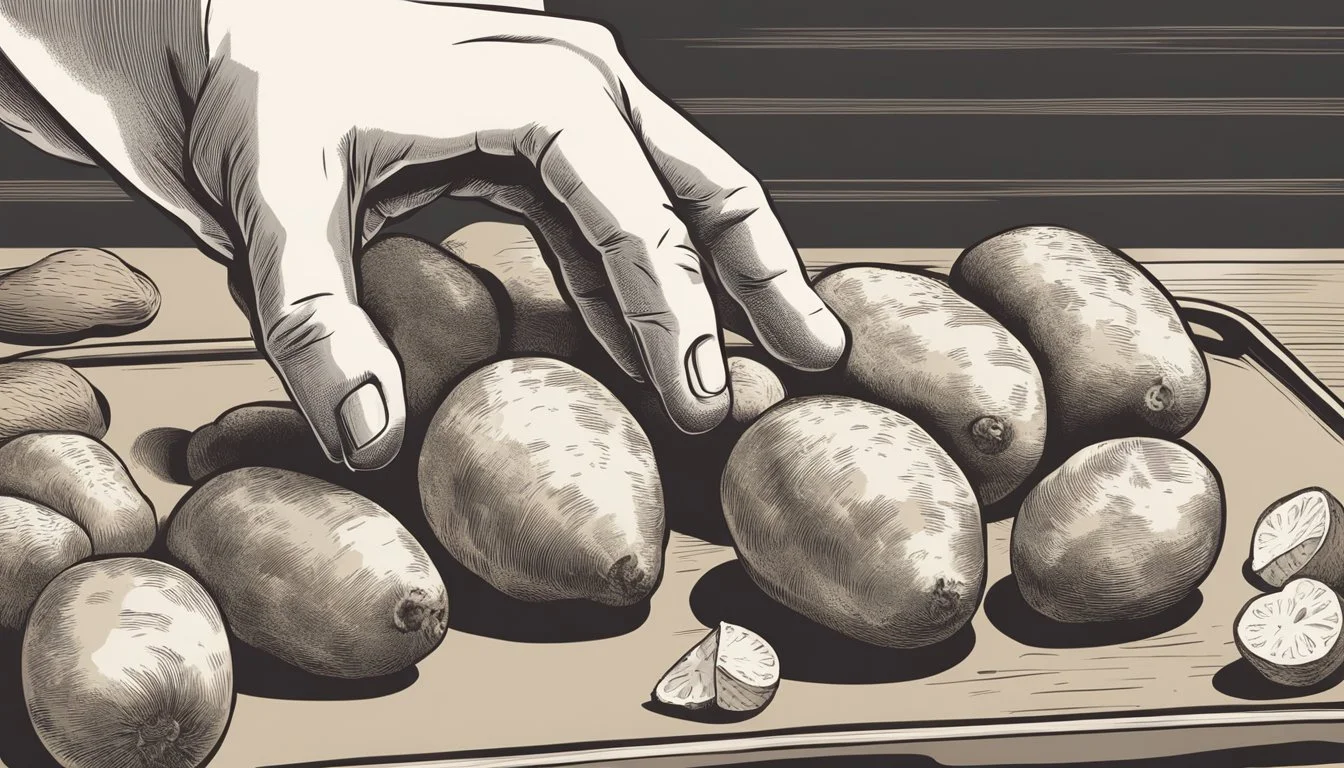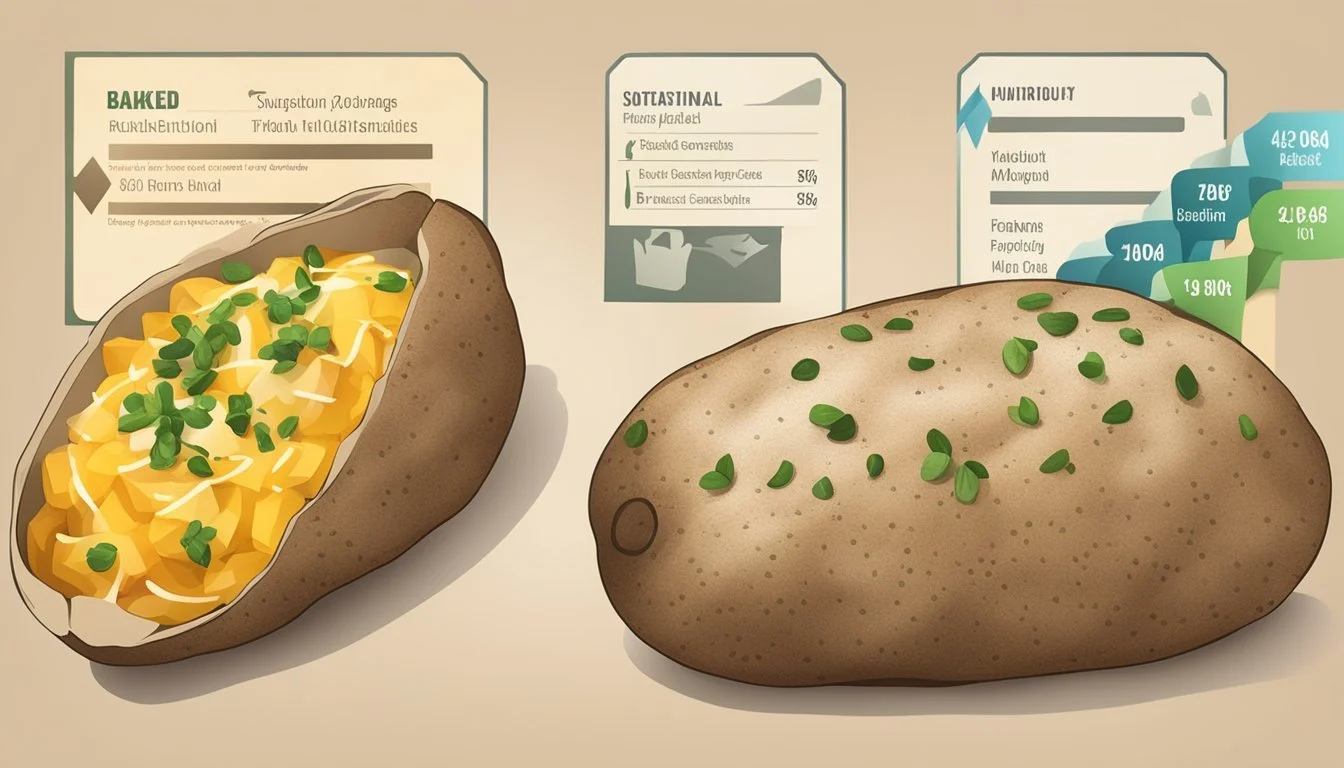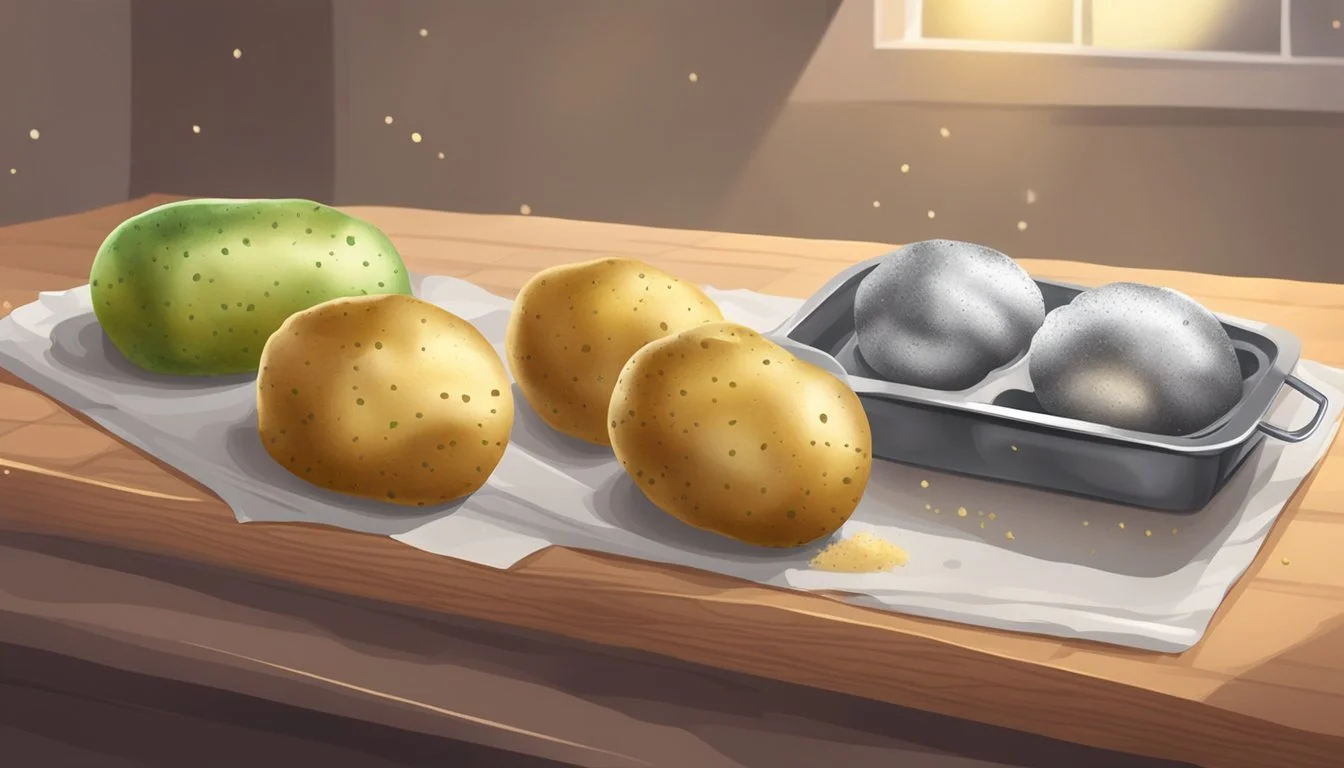How to Cook 4 Perfect Baked Potatoes
Crispy Skin, Fluffy Interior
Baked potatoes are a classic comfort food that's easy to prepare and universally loved. Whether served as a side dish or the main event, these fluffy spuds offer endless topping possibilities. To achieve perfectly baked potatoes, preheat the oven to 425°F (218°C), scrub the potatoes clean, prick them with a fork, and rub them with olive oil and salt before baking for 45-60 minutes.
The key to a great baked potato lies in the preparation and cooking method. Choosing the right type of potato, such as Russet or Idaho, ensures a flaky interior and crispy skin. Proper seasoning and baking time are crucial for developing flavor and achieving the ideal texture.
While cooking methods may vary, the oven-baked approach remains a favorite for its reliability and hands-off nature. This method allows for even cooking and produces that coveted crispy exterior. With a few simple steps, anyone can master the art of baking potatoes to perfection.
Selecting the Right Potato
Choosing the ideal potato is crucial for achieving perfectly baked potatoes. The type and size of potatoes you select will significantly impact the texture and flavor of your dish.
Types of Potatoes for Baking
Russet potatoes are the top choice for baking. Their high starch content results in a fluffy interior and crispy skin when baked. These potatoes have a neutral flavor that pairs well with various toppings.
Yukon Gold potatoes are another option, offering a slightly buttery taste and creamy texture. While not as fluffy as russets, they still produce excellent baked potatoes.
High-starch potatoes are generally preferred for baking. They absorb flavors well and create a light, airy texture when cooked.
The Importance of Potato Size and Uniformity
The size of the potatoes matters when baking. Medium-sized potatoes, about 5-7 ounces each, are ideal for individual servings. They cook evenly and provide a good balance of skin to flesh.
Uniformity in size is key when baking multiple potatoes. Choose potatoes of similar size to ensure they cook at the same rate. This helps avoid undercooked or overcooked potatoes in your batch.
Larger potatoes may require longer cooking times, while smaller ones might dry out if baked for too long. Adjust cooking times accordingly based on the size of your selected potatoes.
Preparing the Potatoes for Baking
Proper preparation is key to achieving perfectly baked potatoes. The process involves cleaning, poking holes, and seasoning to ensure crispy skin and fluffy interiors.
Cleaning and Drying
Start by thoroughly scrubbing the potatoes under cool running water. Use a vegetable brush to remove any dirt or debris from the skin. This step is crucial for food safety and enhances the flavor of the potato skin.
Once cleaned, pat the potatoes dry with a clean kitchen towel or paper towels. Removing excess moisture helps the skin crisp up during baking.
For best results, choose potatoes of similar size to ensure even cooking. Russet potatoes are ideal for baking due to their high starch content and thick skins.
Poking Holes with a Fork
After cleaning and drying, use a fork to poke several holes in each potato. This allows steam to escape during cooking, preventing the potatoes from bursting in the oven.
Create 8-12 evenly spaced holes around the surface of each potato. Pierce about 1/4 inch deep into the skin.
Properly vented potatoes will cook more evenly and develop a fluffier interior texture.
Oil and Seasoning
Lightly coat each potato with olive oil or canola oil. Use your hands to rub the oil evenly over the entire surface.
Sprinkle kosher salt over the oiled potatoes. The salt enhances flavor and helps create a crispy skin.
For additional flavor, consider adding:
Freshly ground black pepper
Garlic powder
Dried herbs like rosemary or thyme
Place the prepared potatoes on a baking sheet lined with parchment paper or directly on the oven rack for optimal heat circulation.
Baking the Potatoes
Baking potatoes results in fluffy interiors and crispy skins. The oven method is reliable, but other techniques can also produce tasty results. Proper doneness ensures potatoes are cooked through without becoming dry or overcooked.
Oven Method
Preheat the oven to 425°F (218°C). Wash and dry 4 medium russet potatoes. Pierce each potato several times with a fork. Rub the skins lightly with oil and sprinkle with salt.
Place the potatoes directly on the oven rack or on a baking sheet lined with parchment paper. Bake for 50-60 minutes, depending on size. Larger potatoes may need up to 75 minutes.
For crispier skins, wrap potatoes in foil for the first 45 minutes, then unwrap and continue baking for 10-15 minutes. This method allows steam to escape, crisping the skin.
How to Determine Doneness
Potatoes are done when the internal temperature reaches 210°F (99°C). Use an instant-read thermometer to check. Insert it into the thickest part of the potato.
Alternatively, gently squeeze the potato with an oven mitt. It should feel soft and give slightly. A skewer or fork should easily pierce the center with little resistance.
The skin should be crisp and slightly wrinkled. Avoid overbaking, which can dry out the potato's interior. If unsure, it's better to check early and continue cooking if needed.
Alternate Cooking Methods
Microwave: Pierce potatoes and cook on high for 5 minutes. Turn and cook for another 3-5 minutes. Let stand for 2 minutes before serving. This method is quick but may not achieve crispy skins.
Air fryer: Cook at 400°F (204°C) for 30-40 minutes, turning halfway through. This produces crispy skins and fluffy interiors in less time than a conventional oven.
Slow cooker: Wrap potatoes in foil and cook on low for 8-10 hours or on high for 4-5 hours. This method is convenient but doesn't create crispy skins.
Grill: Wrap potatoes in foil and grill over medium heat for 45-60 minutes, turning occasionally. This adds a smoky flavor to the potatoes.
Achieving the Perfect Texture
The key to exceptional baked potatoes lies in creating a fluffy interior and crispy skin while maintaining proper moisture. Mastering these elements ensures a delicious result every time.
Fluffy Interior and Crispy Skin
To achieve a fluffy interior, start by choosing starchy potatoes like Russets. Pierce the skin several times with a fork before baking to allow steam to escape. This prevents a soggy interior.
For crispy skin, brush the potatoes with oil and sprinkle with salt before baking. Place them directly on the oven rack or use a wire rack on a baking sheet. This allows hot air to circulate around the entire potato.
Bake at a high temperature, around 425°F (218°C), for 45-60 minutes. The exact time depends on the size of your potatoes. Test for doneness by gently squeezing the potato - it should yield easily.
Maintaining Moisture
Proper moisture balance is crucial for the perfect baked potato. Avoid wrapping potatoes in foil, as this traps steam and leads to a soggy texture.
Instead, brush the skin with oil before baking. This helps retain moisture inside while allowing the exterior to crisp up. For extra moisture, cut the potato open immediately after baking and fluff the interior with a fork.
If reheating pre-baked potatoes, place them in a 350°F (175°C) oven for 15-20 minutes. This restores crispness to the skin and ensures the interior is heated through without drying out.
Customizing Your Baked Potato
Baked potatoes offer a versatile canvas for culinary creativity. From classic toppings to innovative combinations, the possibilities are endless. Adapting your potato toppings can cater to various dietary needs and preferences.
Classic Toppings
Butter, sour cream, and cheddar cheese form the foundation of traditional baked potato toppings. A pat of butter melts into the fluffy interior, while a dollop of sour cream adds tangy richness. Shredded cheddar cheese, sprinkled generously, melts to perfection.
Crispy bacon bits provide a savory crunch. Chives or finely chopped green onions contribute a fresh, mild onion flavor. A sprinkle of black pepper enhances the overall taste profile.
For a heartier meal, consider transforming your potato into a loaded baked potato. Add all the classic toppings plus extra cheese and bacon for an indulgent treat.
Innovative Toppings and Variations
Broccoli and cheddar create a delicious vegetable-cheese combo. Steam small broccoli florets and mix with melted cheddar for a nutritious topping.
For a Mexican-inspired variation, top your potato with guacamole, salsa, and black beans. This combination adds vibrant flavors and textures.
Try topping your potato with chili for a satisfying meal. Use beef or vegetarian chili, then add cheese and sour cream.
Experiment with different cheeses like feta, goat cheese, or blue cheese for unique flavor profiles. Roasted vegetables, pesto, or caramelized onions can also elevate your baked potato.
Dietary Considerations
For vegetarian options, omit bacon and focus on cheese, vegetables, and plant-based toppings. Vegan alternatives include dairy-free cheese, cashew cream, or nutritional yeast.
Low-fat options can include Greek yogurt instead of sour cream, and lean turkey bacon or Canadian bacon instead of regular bacon.
For added nutrition, use sweet potatoes as a base. They offer different flavors and increased vitamin A content.
Gluten-free diners can enjoy most traditional toppings, but should be cautious with pre-made toppings like chili, which may contain gluten.
Serving and Pairing
Baked potatoes pair wonderfully with a variety of side dishes and entrees. The key is balancing flavors and textures to create a satisfying meal.
Ideal Side Dishes
Crisp salads complement the soft texture of baked potatoes. A mixed green salad with vinaigrette dressing adds freshness. Coleslaw provides a cool, crunchy contrast.
Roasted vegetables like broccoli, carrots, or Brussels sprouts offer rich flavors. Their caramelized edges pair nicely with potato skins.
Steamed green beans or asparagus spears lighten the meal. A pat of butter or sprinkle of lemon juice enhances these sides.
For a heartier option, baked beans or chili make excellent toppings and sides. Their protein and fiber create a more filling meal.
Entree Pairings
Grilled or roasted meats are classic pairings for baked potatoes. A juicy steak, whether ribeye or sirloin, is a timeless choice. The potato soaks up the meat's juices deliciously.
Chicken, whether grilled, roasted, or fried, offers a lighter protein option. Barbecue chicken adds tangy flavors that contrast the potato's mild taste.
For vegetarian meals, grilled portobello mushrooms provide a meaty texture. Roasted chickpeas or lentil loaf offer protein-rich alternatives.
Fish like salmon or cod can be baked alongside potatoes for an easy one-pan meal. Their delicate flavors balance the potato's earthiness.
Storage and Reheating
Proper storage and reheating techniques ensure leftover baked potatoes retain their flavor and texture. Following best practices helps maintain food safety and quality.
Storing Leftover Baked Potatoes
Allow baked potatoes to cool completely before storing. Place them in an airtight container or resealable plastic bag. Refrigerate within 2 hours of cooking.
Properly stored, baked potatoes can last 3-4 days in the fridge. For longer storage, freeze them. Wrap cooled potatoes individually in foil, then place in freezer bags.
Frozen baked potatoes can last up to 6 months. Label containers with the date to track freshness.
Best Reheating Practices
Oven reheating produces the best results for crispy skin. Preheat to 350°F (175°C). Place potatoes directly on the rack or a baking sheet. Heat for 15-20 minutes until warmed through.
For quicker reheating, use a microwave. Cut potatoes in half, cover with a damp paper towel. Microwave on high for 2-3 minutes, checking frequently.
Air fryers offer another efficient option. Set to 350-400°F (175-200°C) and heat for 3-4 minutes. Check and adjust time as needed.
To prevent drying, add a small amount of butter or oil before reheating. Avoid reheating potatoes multiple times for food safety reasons.
Nutritional Information
Baked potatoes are a nutritious food choice packed with essential vitamins and minerals. A medium-sized baked potato (about 173 grams) contains approximately 160-190 calories.
Potatoes are an excellent source of vitamin C, providing about 28% of the daily recommended intake. They also contain significant amounts of potassium, vitamin B6, and manganese.
Fiber is another key component of baked potatoes. A single medium potato with the skin on offers around 4 grams of fiber, contributing to digestive health and feelings of fullness.
The macronutrient breakdown of a medium baked potato is as follows:
Nutrient Amount Carbohydrates 37 grams Protein 4.3 grams Fat 0.2 grams
Baked potatoes are naturally low in fat and cholesterol-free. They provide complex carbohydrates, which are a good energy source for the body.
It's important to note that the nutritional value can change significantly depending on toppings added. Common additions like butter, cheese, or sour cream increase calorie and fat content.
For those watching their calorie intake, opting for healthier toppings such as Greek yogurt, salsa, or herbs can maintain the potato's nutritional benefits while adding flavor.
Common Variations and Related Dishes
Baked potatoes serve as a versatile base for many delicious variations and related dishes. These adaptations showcase the potato's ability to transform into comforting soups, creamy salads, and indulgent side dishes.
Loaded Potato Soup
Loaded potato soup captures the essence of a baked potato in liquid form. This hearty soup combines creamy potatoes with classic toppings like cheese, bacon, and chives. To prepare, cook diced potatoes in broth until tender, then blend until smooth. Add cream, cheese, and cooked bacon bits. Garnish with sour cream, extra cheese, and chopped green onions.
For a lighter version, use milk instead of cream and turkey bacon as a substitute. Some recipes incorporate vegetables like carrots or celery for added nutrition and flavor. Serve with crusty bread for a complete meal.
Baked Potato Salad
Baked potato salad offers a twist on traditional potato salad by using baked potatoes instead of boiled ones. This results in a unique texture and flavor profile. Start by baking potatoes until tender, then cool and cube them. Mix with mayonnaise, sour cream, chopped bacon, shredded cheese, and green onions.
Add diced red onions and celery for crunch. Season with salt, pepper, and garlic powder to taste. For extra flavor, include mustard or ranch dressing. Chill before serving to allow flavors to meld. This salad works well for picnics and barbecues.
Twice Baked Potatoes
Twice baked potatoes elevate the classic baked potato by refilling the skins with a creamy mixture. Bake potatoes, then scoop out the insides. Mash the potato flesh with butter, milk, cheese, and seasonings. Refill the skins with this mixture and top with more cheese.
Bake again until the cheese melts and the tops are golden brown. Customize by adding bacon, chives, or jalapeños. For a healthier version, use Greek yogurt instead of sour cream and add steamed broccoli to the filling.
Mashed Potatoes
Mashed potatoes transform baked potatoes into a creamy side dish. Bake potatoes, then scoop out the flesh. Mash with warm milk, butter, salt, and pepper. For extra smoothness, use a ricer or food mill. Add roasted garlic, herbs, or cheese for variety.
To achieve fluffy mashed potatoes, avoid overmixing. For a richer version, use cream instead of milk. Leftover mashed potatoes can be used to make potato cakes or added to soups for thickness. Serve alongside roasted meats or as a base for gravy.





